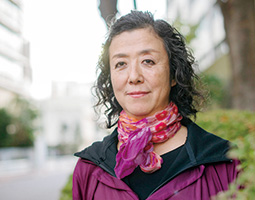Home > Highlighting JAPAN > Highlighting Japan December 2019 > Shall We Dance?
Highlighting JAPAN


The Meteoric Rise of Street Dance
Since its introduction to Japan in the 1980s, street dance has soared in popularity and now ranks alongside sports such as baseball and volleyball at schools.
It’s a tense battle, pitting the infectiously energetic team Jagarico against the subtle guile of team Mitsuya Cider.
One after another, the four members of each team take to the floor to show off their skills in one of four genres – hip-hop; pop; lock; and freestyle. At this stage of the contest, high-level technique is a given: It’s all about flair, attitude and originality, and both teams have those in spades.
By the slimmest of margins, the judges declare team Jagarico as “battle park” champions for 2019, marking the climax of the Shibuya Street Dance Week (SSDW) in Tokyo.
“I’m totally stoked,” said Jagarico member Takamatsu Yuta, an elementary school fifth grader whose electrifying display in the pop category – performed in pinstripe suit and trilby hat and supplemented by an array of amusing facial expressions – brought the crowd of spectators alive.
SSDW, which takes place at venues around Shibuya and features contests and workshops aiming to introduce street dance to as wide an audience as possible, is a relative newcomer to the Japan street dance scene, but has quickly garnered a healthy following. This year’s event attracted some 39,000 visitors – almost triple that of the inaugural year in 2015.
Street dance first found its way to Japan in the 1980s via the Bronx district of New York, where since the seventies genres such as b-boying/b-girling and hip-hop had evolved organically on the streets to become an integral part of vernacular culture.
Its growth in Japan started with the late night airing of popular American TV music program “Soul Train” and was further boosted by the arrival of Music Television (MTV), which first hit the airwaves here in the latter part of the eighties.
A few years later the pop sensation TRF, whose DJ Koo influenced riffs and street-heavy dance moves – courtesy of dance legends Sam, Etsu and Chiharu – inspired an entire generation of wannabe hip-hoppers.
By the mid nineties, the sight of Japanese youth popping, locking and toprocking about town was common nighttime fare – especially where there was any kind of reflective glass, such as the facades of business high-rises and department stores.
If at a glance their gyrations seemed narcissistic, some perspective was gained from the countless contests and other street dance events that were gaining traction, especially in major conurbations such as Osaka and Tokyo.
Furthermore, street dance schools and studios – a seeming contradiction for a dance genre heavily reliant on improvisation – were opening up one after another. One such company was Avex – the record label producing TRF, Amuro Namie and other dance-heavy acts – whose “Avex Dance Master” program was introduced in Tokyo in 2001, before spreading to other parts of the country.
Street Dance’s popularity stepped up several notches from 2013 after the Japanese government introduced it into the education curriculum to supplement two other genres, folk and “creative” (essentially ballroom dancing). The rationale behind its introduction, made under the moniker “modern rhythm dance,” was that it could “enrich student communication through image-based expression and dance,” according to the Ministry of Education, Culture, Sports, Science and Technology’s website.
Now there are more than 2,000 street dance clubs at senior high schools alone, according to the Osaka-based Street Dance Association. Street dance is becoming as popular as major sports such as baseball and volleyball at schools, and Japan’s street dance population, including rhythm dance, is estimated to reach at least 20 million by 2020.
Another organized event that has gradually found favor nationwide are the numerous dance battles such as the one that formed a centerpiece of Shibuya Street Dance Week, says Nakanishi Sachiko, a producer at the entertainment division of the Shibuya-headquartered PARCO department store chain and one of the masterminds of the Shibuya street dance event, which is organized by Arts Council Tokyo.
“Street dance is clearly no temporary fad, but something that has taken a firm root in modern youth culture,” says Nakanishi, adding that Shibuya is the nation’s undisputed street dance Mecca. “When I was at school, students who played baseball were the cool ones in the class, and then a little later it was the kids who played soccer. Nowadays, it’s those who do street dance.”
Another highlight of the Shibuya event was a contest held entirely for high school teams, who competed on the outdoor stage in Tokyo’s Yoyogi Park. The winner was a team from Komae High School in Tokyo, which is coached by alumni and professional dancer Yazawa Asuka.
“One of the big differences with street dance in Japan now is that some of these people will certainly go on to perform professionally, maybe even internationally,” she says. “It’s pretty common now to see Japanese street dancers performing overseas.”
DJ Hiroking, who provided the music for the dance battle during the event, agrees, adding: “Ever since SSDW started in 2015, the level of participants across the age groups has increased markedly. It’s exciting to think what next year might bring.”
© 2009 Cabinet Office, Government of Japan









